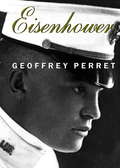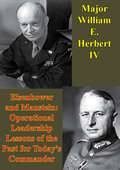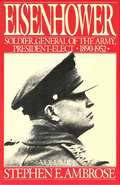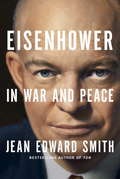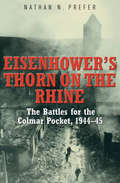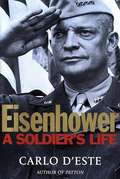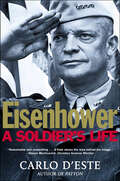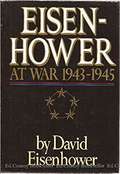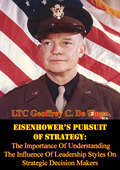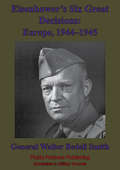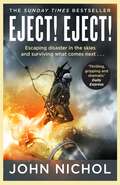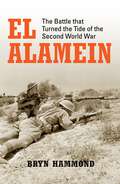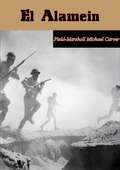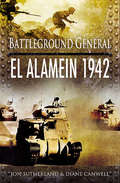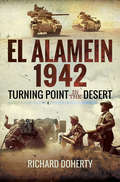- Table View
- List View
Eisenhower
by Geoffrey PerretDrawing on newly available material, including Eisenhower's papers and diaries, author and military historian Geoffrey Perret offers a comprehensive portrait of the life, military exploits, political life, and presidency of Dwight D. Eisenhower (1890-1969). He covers several controversies including an alleged dalliance, Eisenhower's break with MacArthur in 1939, his opinion of Nixon, and his role in McCarthy's activities. Annotation c. Book News, Inc., Portland, OR (booknews.com)
Eisenhower
by Paul JohnsonAcclaimed historian Paul Johnson's lively, succinct biography of Dwight D. Eisenhower explores how his legacy endures today In the rousing style he's famous for, celebrated biographer Paul Johnson offers a fascinating portrait of Dwight D. Eisenhower, focusing particularly on his years as a five-star general and his time as the thirty-fourth President of the United States. Johnson chronicles President Eisenhower's modest childhood in Kansas, his college years at West Point, and his rapid ascent through the military ranks, culminating in his appointment as Supreme Commander of the Allied Forces in Europe during World War II. Beginning when Eisenhower assumed the presidency from Harry Truman in 1952, Johnson paints a rich portrait of his two consecutive terms, exploring his volatile relationship with then-Vice President Richard Nixon, his abhorrence of isolationism, and his position on the Cold War, McCarthyism, and the Civil Rights Movement. Johnson notes that when Eisenhower left the White House at age 70, reluctantly passing the torch to President-elect John F. Kennedy, he feared for the country's future and prophetically warned of the looming military-industrial complex. Many elements of Eisenhower's presidency speak to American politics today, including his ability to balance the budget and skill in managing an oppositional Congress. This brief yet comprehensive study will appeal to biography lovers as well as to enthusiasts of presidential history and military history alike.
Eisenhower
by Paul JohnsonAcclaimed historian Paul Johnson's lively, succinct biography of Dwight D. Eisenhower explores how his legacy endures today In the rousing style he's famous for, celebrated biographer Paul Johnson offers a fascinating portrait of Dwight D. Eisenhower, focusing particularly on his years as a five-star general and his time as the thirty-fourth President of the United States.Johnson chronicles President Eisenhower's modest childhood in Kansas, his college years at West Point, and his rapid ascent through the military ranks, culminating in his appointment as Supreme Commander of the Allied Forces in Europe during World War II. Beginning when Eisenhower assumed the presidency from Harry Truman in 1952, Johnson paints a rich portrait of his two consecutive terms, exploring his volatile relationship with then-Vice President Richard Nixon, his abhorrence of isolationism, and his position on the Cold War, McCarthyism, and the Civil Rights Movement. Johnson notes that when Eisenhower left the White House at age 70, reluctantly passing the torch to President-elect John F. Kennedy, he feared for the country's future and prophetically warned of the looming military-industrial complex.Many elements of Eisenhower's presidency speak to American politics today, including his ability to balance the budget and skill in managing an oppositional Congress. This brief yet comprehensive study will appeal to biography lovers as well as to enthusiasts of presidential history and military history alike.
Eisenhower
by Steven Zaloga Steve NoonDwight Eisenhower represented a fundamentally new type of military commander in the 20th century: commander as manager rather than the traditional warrior commander. Armies had become so large and military coalitions so dependent on politics that this new type of commander emerged. Eisenhower never fought in a single battle, but he commanded the most modern and powerfully armed force to fight in Europe. As Supreme Commander of the Allied Expeditionary Force, Eisenhower had at his disposal not only the British, US, and French armies, but the RAF, USAAF, Royal Navy and US Navy-Atlantic. This book explores every aspect of his military career.From the Trade Paperback edition.
Eisenhower And Manstein: Operational Leadership Lessons Of The Past For Today's Commanders
by Major William E. Herbert IVThe United States Military, the ultimate Instrument of national resolve, is centered on servicemen and women. Without effective leadership these men and women are ill equipped to succeed in combat and are unjustly put in harm's way. The commander at the operational level is the link between national policy and action. His actions, character and decisions are of historical importance. While this paper will not cover the full spectrum of operational leadership; the most important traits of operational leadership will be explored. Additionally, this paper will highlight recent failures in operational leadership and compare and contrast them with lessons learned from two diametrically opposed operational leaders of World War II, General Dwight Eisenhower and Field Marshall Erich von Manstein. Analysis will concentrate on the specific operations of the Normandy invasion and Kharkov. The analysis will not deconstruct the operations but rather center on the operational leadership traits each commander displayed and their importance to the operation. Finally the paper will show how the lessons of sixty-five years ago are applicable today and for the future.
Eisenhower Volume I: Soldier, General of the Army, President-Elect, 1890-1952
by Stephen E. AmbroseDwight Eisenhower was not exactly born into poverty, but the family's circumstances were at least austere. He was one of seven children; his father, a railway worker. But the family was strong and unified, the youngsters energetic and ambitious.<P> Ike made it to West Point, where he excelled in sports. He was a natural leader. But it was at Leavenworth years later, as a student at the war college, that his intellectual talent showed itself. He graduated first in his class.<P> The author draws in a wealth of previously unpublished information to give us this beautiful portrait. As a result Eisenhower emerges as complex, one who as the author states, ". . .was a good and great man."
Eisenhower and Churchill: The Partnership that Saved the World
by James C. HumesAlthough born and raised more than an ocean apart, Dwight Eisenhower and Winston Churchill—the two titans of the greatest generation—led remarkably parallel lives whose paths would intersect during history's most harrowing days. Through their youth, education, and military training, both men experienced similar triumphs and failures that shaped their lives, though they met only for the first time upon the eve of war in 1941. Eisenhower and Churchilltells the magnificent story of these two great leaders and their exemplary partnership in war and peace. Through enlivened pages and fascinating anecdotes, author James C. Humes illuminates the human side of each man, who had more in common with each other than a world war. You'll discover the extraordinary stories of how both were born to domineering mothers and failed fathers, both did not qualify for the military academy on the first try, both were traumatized by experiences in World War I, both were talented writers, and both lost a child in the very same year (1921). Remarkably, each man did not warm to the other at first; but as they worked together, their respect for one another grew to become a powerful friendship that lived long after the echoes of war had receded into the past. As allies, they shared a hatred for tyranny and led the world through the greatest war of the twentieth century. As friends, they shared a sense of trust and cooperation that should be raised as a standard. Containing new research and memorable insights,Eisenhower and Churchillbrings to life the two lions of the twentieth centruy. "Who would not welcome an intimate book about Churchill and Eisenhower, and who is better situated to write it than Professor Humes, who knew them both, and studiously—and ardently—records their careers and their friendship?" —William F. Buckley Jr. "James C. Humes'sEisenhower and Churchillis a wonderful dual biography laced with lively anecdotes, engaging prose, and shrewd analysis. A truly welcome addition to our growing literature on the Second World War. " —Douglas Brinkley,professor of history and director of the Eisenhower Center, University of New Orleans From the Hardcover edition.
Eisenhower in War and Peace
by Jean Edward SmithIn his magisterial bestseller FDR, Jean Edward Smith gave us a fresh, modern look at one of the most indelible figures in American history. Now this peerless biographer returns with a new life of Dwight D. Eisenhower that is as full, rich, and revealing as anything ever written about America's thirty-fourth president. As America searches for new heroes to lead it out of its present-day predicaments, Jean Edward Smith's achievement lies in reintroducing us to a hero from the past whose virtues have become clouded in the mists of history. Here is Eisenhower the young dreamer, charting a course from Abilene, Kansas, to West Point, to Paris under Pershing, and beyond. Drawing on a wealth of untapped primary sources, Smith provides new insight into Ike's maddening apprenticeship under Douglas MacArthur in Washington and the Philippines. Then the whole panorama of World War II unfolds, with Eisenhower's superlative generalship forging the Allied path to victory through multiple reversals of fortune in North Africa and Italy, culminating in the triumphant invasion of Normandy. Smith also gives us an intriguing examination of Ike's finances, details his wartime affair with Kay Summersby, and reveals the inside story of the 1952 Republican convention that catapulted him to the White House.Smith's chronicle of Eisenhower's presidential years is as compelling as it is comprehensive. Derided by his detractors as a somnambulant caretaker, Eisenhower emerges in Smith's perceptive retelling as both a canny politician and a skillful, decisive leader. Smith convincingly portrays an Eisenhower who engineered an end to America's three-year no-win war in Korea, resisted calls for preventative wars against the Soviet Union and China, and boldly deployed the Seventh Fleet to protect Formosa from invasion. This Eisenhower, Smith shows us, stared down Khrushchev over Berlin and forced the withdrawal of British, French, and Israeli forces from the Suez Canal. He managed not only to keep the peace--after Ike made peace in Korea, not one American soldier was killed in action during his tenure--but also to enhance America's prestige in the Middle East and throughout the world.Domestically, Eisenhower reduced defense spending, balanced the budget, constructed the interstate highway system, and provided social security coverage for millions who were self-employed. Ike believed that traditional American values encompassed change and progress.Unmatched in insight, Eisenhower in War and Peace at last gives us an Eisenhower for our time--and for the ages.From the Hardcover edition.
Eisenhower on the War: The Complete Report By The Supreme Commander On The War In Europe
by Dwight D. EisenhowerFirst published in 1946 as Eisenhower’s Own Story of the WarTHIS is one of the truly great documents in the history of human conflict. It is the personal, yet definitive report of the world’s mightiest military operation, written by the one man qualified to write it, the man under whose Supreme Command the Allied forces rode to triumph. A classic of information, in the plain language for which our Chief of Staff is famous, it reveals the whole inside story of how the war was run and won.
Eisenhower's Thorn on the Rhine: The Battles for the Colmar Pocket, 1944–45
by Nathan N. Prefer&“The difficult fighting in the Colmar Pocket is brought to vivid life&” in this WWII chronicle of the Allied 6th Army Group (WWII History). By the fall of 1944, the Western Allied forces appeared to be unstoppable. The summer&’s Normandy invasion had driven the Germans out of northern France and most of the Low Countries. In September, they liberated France&’s southern coast with little opposition. Then, Allied divisions began lining up along the Rhine. While the Americans met a nasty surprise in the Ardennes, the Germans also held on to the province of Alsace, maintaining a hard pocket around the city of Colmar. On New Year&’s Eve, they launched Operation Northwind, a counteroffensive that nearly put Allied forces back on their heels. On January 12, 1945, Eisenhower could only tell George Marshall that Colmar was &“a very bad thorn in our side today.&” This is the story of the Sixth Army Group, a unit that combined US and French forces, and its unexpectedly bloody and protracted battle for the Colmar Pocket. Amidst a horrific winter and rough terrain, interspersed by demolished towns, the Allied Army Group traded blows with the German 19th in a ferocious campaign. This book informs us fully of the tremendous and costly struggle waged in an often-neglected sector of World War II&’s European Theater.
Eisenhower: A Biography (Great Generals Series)
by John Wukovits“A concise portrayal of the commander who served as the chief architect of D-Day.” —Col. Cole C. Kingseed, New York Times–bestselling coauthor of Beyond Band of BrothersAmerican general and thirty-fourth US president Dwight D. Eisenhower was the principal architect of the successful Allied invasion of Europe during World War II, and the subsequent defeat of Nazi Germany. In this biography, military historian John Wukovits explores Eisenhower’s contributions to American warfare. Eisenhower led the assault on the French coast at Normandy and held together the Allied units through the European campaign that followed. The book reveals Eisenhower’s advocacy in the pre-war years of the tank, his friendships with George Patton and Fox Conner, his service in the Philippines with Douglas MacArthur, and his culminating role as supreme commander of Allied forces in Europe.With an introduction by General Wesley Clark, Eisenhower skillfully demonstrates how Dwight Eisenhower’s evolution as a commander, his military doctrine, and his diplomatic skills are of extreme importance in understanding modern warfare.“A portrait of a general who devised and sustained a broad-front strategy that led to Germany’s unconditional surrender, and a man who never took his eyes off the prize.” —The Star-Ledger
Eisenhower: A Soldier's Life
by Carlo D'EsteFrom the bestselling author of Patton: A Genius for War comes a compelling new account of the transformation of General Dwight D. Eisenhower, from apprehensive soldier to one of our greatest heros. In the weeks leading up to D-Day, Dwight D. Eisenhower seethed with nervous energy. He had not expected his military career to bring him to this moment. The son of pacifists, Ike graduated from high school more likely to teach history than to make it. Casting new light on this profound evolution, Eisenhower chronicles the unlikely, dramatic rise of the supreme Allied commander. Beginning with the lasting effect of Eisenhower's impoverished youth, bestselling biographer Carlo D'Este follows his subject through West Point and a sometimes troubled marriage; toil under MacArthur in the Philippines during the 1930s; the inner sanctums of the War Department; the general's painful North African apprenticeship; and, finally, the dramatic events leading to the Allied victory in May 1945. Exposing for the first time numerous myths that have surrounded the war hero and his family (such as his romance with his wartime driver, Kay Summersby), D'Este also probes Eisenhower's famous clashes with his American peers and the British chiefs of staff, as well as his relations with legendary figures, including Winston Churchill and George S. Patton. Unlike other biographies of the general, Eisenhower captures Ike's true character, from his youth to the pinnacle of his career and afterward.
Eisenhower: A Soldier's Life
by Carlo D'EsteThe acclaimed biographer presents an intimate and comprehensive portrait of the legendary president and WWII general: “An excellent book.” —The Washington Post Book WorldBorn into hardscrabble poverty in rural Kansas, the son of stern pacifists, Dwight David Eisenhower graduated from high school more likely to teach history than to make it. Yet he went on to become one of America’s most important military leaders. Then, on the wings of victory, the career soldier ascended to the nation’s highest political office. Casting new light on this profound evolution, Carlo D’Este chronicles the unlikely, dramatic rise of the supreme Allied commander.With full access to private papers and letters, D’Este has exposed for the first time the countless myths that have surrounded Eisenhower and his family for over fifty years. In this revealing biography, he identifies the complex and contradictory character behind Ike’s famous grin and air of calm self-assurance.
Eisenhower: At War 1943-1945
by David EisenhowerThe first volume of a multi-volume study of President Eisenhower, this book focuses on Eisenhower's conduct of the war and provides an extensively documented analysis of the political ramifications of the course of the war and Eisenhower's decisions
Eisenhower: Becoming the Leader of the Free World (The\papers Of Dwight David Eisenhower Ser.)
by Louis Galambos"Highly accessible and sprightly written."—Library JournalWinner of the Kansas State Library's Kansas Notable Book AwardIn this engaging, fast-paced biography, Louis Galambos follows the career of Dwight D. "Ike" Eisenhower, offering new insight into this singular man who guided America toward consensus at home and a peaceful victory in the Cold War.The longtime editor of the Eisenhower papers, Galambos may know more about this president than anyone alive. In this compelling book, he explores the shifts in Eisenhower's identity and reputation over his lifetime and explains how he developed his distinctive leadership skills. As a career military officer, Eisenhower's progress was uneven. Galambos shows how Ike, with the help of Brigadier General Fox Conner, his mentor and patron, learned how to profit from his mistakes, pivot quickly, and grow as a military and civilian leader. On D-Day, Eisenhower guided the largest amphibious force in history to a successful invasion of France and a decisive victory. After the defeat of Nazi Germany, he turned to politics and was elected president in 1952.While today's fiercely partisan political climate makes it difficult to imagine a president forging consensus in Washington, that's exactly what Eisenhower did. As America's leader in an era of profound postwar changes at home and abroad, President Eisenhower sought a middle way with compromise and coalition building. He provided his country with firm-handed leadership, bringing prosperity and peace to the American people in the dangerous years of the Cold War—an accomplishment that made him one of the most influential men of the twentieth century. Destined to be the best short biography of the thirty-fourth president of the United States, Eisenhower conclusively demonstrates how and why this master of the middle way became the successful leader of the free world.
Eisenhower’s Pursuit Of Strategy: The Importance Of Understanding The Influence Of Leadership Styles On Strategic Decision Makers
by LTC Geoffrey C. De TingoEisenhower preferred to build consensus for his military and national strategies by using multiple communication techniques to convey his intent. If consensus was not achieved, though, and his intent was not carried out he would aggressively move to eliminate the source of friction. This monograph will analyze four case studies to demonstrate that it is critically important for subordinates and peers to understand the influence of leadership styles on strategic decision makers. It will also argue that the consequences for not understanding strategic decision makers can mean the difference between individual, organizational or national success or failure.The four case studies will highlight the leadership styles that Eisenhower used when he pursued a strategy and how those leadership styles influenced his decision-making. The first case study is Eisenhower's fight to control Allied strategic bombers to support Operation Overlord in 1944. Second is his fight to develop, implement and defend his New Look National Security Strategy in 1953. Third is how Eisenhower defended his administration's Middle East foreign policy and finally his strategy to seek a peaceful solution to the Suez Canal Crisis of 1956.
Eisenhower’s Six Great Decisions: Europe, 1944–1945
by General Walter Bedell SmithEisenhower's Chief of Staff reviews the six turning points of the European war that took the Allies from Normandy to the heart of Germany in only 11 months.War, as in life, turns on decisions taken and opportunities taken; the decisions of General Eisenhower as supreme commander of the Allied effort in Europe shaped the lives of millions of soldiers and tens of millions of civilians. The strain of these decisions was shared with many of the top allied commanders, but few will have understood Eisenhower's thought processes than his trusted friend, confidante and chief of staff General Walter Bedell "Beetle" Smith. A shrewd and intelligent man in his own right, the "Beetle" would be constantly by Eisenhower's side as he directed the huge Allied armies against the Wehrmacht across France, Belgium, Holland and finally into Germany itself. He set out to describe the events through the eyes of his friend and superior as they appeared at the time; the six 'Great Decisions' that he decided on as the turning points of the conduct of the war were:1 - The Decision Of The Timing Of Operation Overlord [The Normandy Landings]2 - How To Break Out Of Normandy Bocage3 - How To Deal With The Ardennes Counteroffensive [Battle Of The Bulge]4 - How To Destroy Or Capture All German Forces Against The West Of The Rhine5 - How To Encircle The Industrial Heartland Of Germany - The Ruhr.6 - How To End The War.A must read for anyone interested in the Second World War.
Eject! Eject!
by John Nichol'Eject! Eject!' When the call is made to abandon an aircraft, it's only the beginning of the story... From the Sunday Times bestselling writer John Nichol, author of Spitfire, Lancaster and Tornado, comes a brilliant new book that reveals the astonishing story of an invention that has saved many thousands of lives around the world, including his own: the ejection seat. Nichol tells the remarkable tale of how the ejection seat was first conceived during the Second World War as countless lives were lost in accidents and in battle. In the wake of the war, that technological race to save aircrew lives using explosive seats continued at an incredible pace. Nichol tells the story of the brave men who risked their lives testing those early devices, and interviewed the first British pilot to eject back in 1949, when ejection, from pulling the handle to being under the parachute, took thirty seconds. Today, that figure is down to around one second. Packed with interviews with aircrew who know exactly how it feels to &‘Bang Out&’ from an aircraft at high speed, both in peace and in war, the book gives the reader a vivid sense of what that life-saving experience feels like, but also features the moving accounts of what happens next, from the viewpoint of both the crews and their families, who often have little or no information about whether or not their loved ones have survived. Because ejecting is just the start of a journey….. Packed with dramatic action, incredible science and moving recollections, Eject! Eject! is an essential read.
El Alamein
by Bryn HammondThe battle of El Alamein in 1942 was one of the most crucial events in the entire Second World War. Before it, the British had never won a major battle on land against the Germans; nor indeed had anyone else, even the Russians. At Alamein the British Eighth Army first thwarted the Axis attempts in North Africa to seize Cairo and the Suez Canal and then smashed through the German-Italian defences, eventually driving the Axis forces out of North Africa. This victory, by a 'British' army actually composed of a variety of nationalities including men and women from the Indian sub-continent, southern Africa, Australians, New Zealanders, French and Greeks, as well as British troops, had psychological and morale-raising significance that exceeded even its strategic importance. Nothing had the sweet smell of success prior to this battle than El Alamein and for the battered British Empire battling against the might of the Third Reich this victory was crucial to its ability to continue its war efforts. El Alamein's significance went beyond the events of the war. The opposing army commanders were perhaps the first 'celebrity' generals, attracting the attention of press and newsreel reporters alike. This led to a host of myths and tales of idiosyncratic behaviour that were shamelessly exploited by the individuals themselves and, especially in Britain, eagerly devoured by a public enamoured of the romance of warfare in this remarkable and hostile environment where men were at war with each other as well as with the elements. Drawing on a remarkable array of first-hand accounts, this book reveals the personal experiences of those on the frontline, giving the individual's point of view of the battle, from all sides, and provide a fascinating account of the minutiae detail of how war was actually fought alongside the analysis of the strategic decisions made by the generals. El Alamein 1942 is the story of exactly how a seemingly beaten and demoralized army turned near-defeat into victory in a little over four months of protracted and bloody fighting in the harsh North African desert and of the repercussions of the battle for the participants, for historians and in popular culture.
El Alamein
by Field-Marshal Michael CarverThe Second Battle of El Alamein (23 October - 11 November 1942) was a decisive battle of the Second World War that took place near the Egyptian railway halt of El Alamein and marked the watershed of the Western Desert Campaign. In August 1942, Lt.-Gen. Sir Bernard Law Montgomery took command of the 8th Army, and the British victory turned the tide in the North African Campaign, ending the Axis threat to Egypt, the Suez Canal and the Middle Eastern and Persian oil fields via North Africa.The Second Battle of El Alamein revived the morale of the Allies, being the first major success against the Axis since Operation Crusader in late 1941. The battle coincided with the Allied invasion of French North Africa in Operation Torch, which started on 8 November, as well as the Battle of Stalingrad and the Guadalcanal Campaign.This book, first published in 1962, provides a detailed account of the Second Battle of El Alamein, based on original German and British sources and drawing on the author’s own observations as one of the combatants.
El Alamein 1942
by Pier Paolo BattistelliThe Second Battle of El Alamein was one of the most decisive Allied victories of the Second World War. The Second Battle of El Alamein marked a major turning point in the Western Desert Campaign of the Second World War. El Alamein saw two of the greatest generals of the war pitted against each other: Rommel and Montgomery. Through key profiles and a chapter devoted to “The Armies,” El Alamein 1942 explores what made these men inspired leaders and what led to their respective defeat and victory. Montgomery’s success ensured that the Axis army was unable to occupy Egypt and therefore gain control of the Suez Canal or the Middle Eastern oil fields, thereby preventing a major source of income and power coming to them. The background and impact of the battle are explored in separate chapters, offering the reader clear insight into why what happened in this remote part Egypt was so central to the Allied cause. Through quotes and maps, the text explores the unfolding action of the battle and puts the reader on the front line. If you truly want to understand what happened and why — read the Battle Story.
El Alamein 1942: El Alamein 1942
by Diane CanwellThe Battlefield General game books put you in command of the forces engaged in some of history's most famous battles. Your ability to make the right tactical decision will be tested at every turn of the page. The 2nd Battle of El Alamein in October 1942 was one of the crucial turning points of WWII. Here Lieutenant General Bernard Montgomery ('Monty') and the British Eighth Army (the famous 'Desert Rats') halted the victorious advance of Field Marshal Erwin Rommel (the Desert Fox) and his Afrika Korps. Britain's vital interests in the Middle East, particularly the vital oil fields, were thus saved. The book presents the reader with a series of command decisions, aided by situation maps, directing you to the next relevant briefing depending on the option you choose. No dice are necessary to play, just this book and your tactical skill. When you buy this book, the fate of nations is in your hands.
El Alamein 1942: Turning Point in the Desert
by Richard DohertyThe Battle of El Alamein is well established as a pivotal moment of the Second World War. Following the wildly fluctuating fortunes of the opposing sides, there was a real risk that Rommels Afrika Korps and his Italian allies would break through and seize Cairo with catastrophic strategic and political implications for the Allies. That this never happened is, of course, well known but, as this highly readable yet authoritative work reveals, there were moments of extreme peril and anxiety.Churchills bold, nay desperate, decisions concerning key appointments, Montgomerys stubborn refusal to be rushed, Rommels chronic logistic problems and critical air superiority are all examined in expert detail. The authors description of the actual fighting is brought to life by personal accounts as well as his complete grasp of the plan and tactics involved.The result, seventy-five years on, is a delightfully fresh and fascinating account of one of the iconic battles, not just of the War but in military history.
El Cid: The Life and Afterlife of a Medieval Mercenary
by Nora Berend'A fascinating study of historical mythmaking... Concise and absorbing'Paul Freedman, author of Out of the EastRodrigo Díaz lived a violently colourful life in eleventh-century Spain. An ambitious military leader, exile and brutal mercenary, he served Christian kings, fought against Christian princes in service of Muslim rulers, raided and killed Muslims and eventually struck out on his own, carving out an independent principality. While Rodrigo the man is long dead, El Cid lives on: a superhero; a quasi-saint; the 'spirit of Spain', according to military dictator Franco; and a champion of medieval Spanish multiculturalism. Nora Berend uncovers how el Cid has been transformed across the centuries, confronting the gulf between truth and legend and examining how a military adventurer became a hero to people on opposite ends of the political spectrum. What is it about this man that appeals to us? And why do we transform the most unsuitable people into heroes?'Would the real El Cid please stand up? Nora Berend's fascinating new book covers nearly a thousand years of history and myth-making about this eleventh-century warrior . . . and presents all the delicious ironies of history'Professor Marc David Baer, author of The Ottomans: Khans, Caliphs, and Caesars
El Cid: The Life and Afterlife of a Medieval Mercenary
by Nora Berend'A fascinating study of historical mythmaking... Concise and absorbing'Paul Freedman, author of Out of the EastRodrigo Díaz lived a violently colourful life in eleventh-century Spain. An ambitious military leader, exile and brutal mercenary, he served Christian kings, fought against Christian princes in service of Muslim rulers, raided and killed Muslims and eventually struck out on his own, carving out an independent principality. While Rodrigo the man is long dead, El Cid lives on: a superhero; a quasi-saint; the 'spirit of Spain', according to military dictator Franco; and a champion of medieval Spanish multiculturalism. Nora Berend uncovers how el Cid has been transformed across the centuries, confronting the gulf between truth and legend and examining how a military adventurer became a hero to people on opposite ends of the political spectrum. What is it about this man that appeals to us? And why do we transform the most unsuitable people into heroes?'Would the real El Cid please stand up? Nora Berend's fascinating new book covers nearly a thousand years of history and myth-making about this eleventh-century warrior . . . and presents all the delicious ironies of history'Professor Marc David Baer, author of The Ottomans: Khans, Caliphs, and Caesars
